|
ZANDERLAND - Species - Perch |
|
||
 |
|||
|
Lake Rautavesi |
|||
| The biggest fish bite balanced jigging lures | |||
| Winter fishing | |||
| The humpbacked perch strikes a jig |
|
ZANDERLAND - Species - Perch |
|
||
 |
|||
|
Lake Rautavesi |
|||
| The biggest fish bite balanced jigging lures | |||
| Winter fishing | |||
| The humpbacked perch strikes a jig |
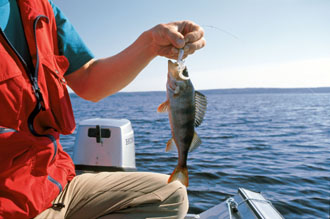 |
The national fish of Finland. |
| The Finnish national fish, the perch, can be found in Finland in water
areas of all sizes and of very different types. In the Tampere Region, good fishing sites
for big perch include Lakes Kyrösjärvi, Keurusselkä, Pyhäjärvi, Kulovesi, Rautavesi
and Ruovesi. There is no end to good ice-fishing waters in the area. In addition to the
hundreds of small lakes, good ice-fishing waters for perch include Lakes Roine, Mallasvesi
and Pälkänevesi, as well as those mentioned above.
Lure fishing for perch is most productive from mid-June to September. In recent years, perch jigging has become an increasingly popular form of fishing. A perch bites a jig in midsummer by the sides of shoals. The best time to really go after big perch is early autumn. Shallows located close to deeps and rapid-flowing straits are the best perch spots in autumn. In midsummer you can troll perch with small plugs. |
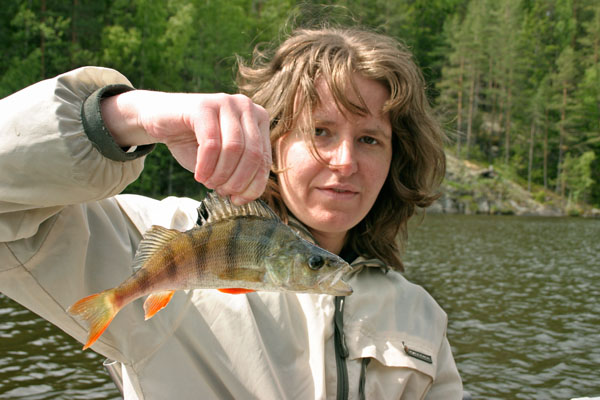 |
| A hunting perch strikes fiercely |
| The best season
for jigging big perch starts as the water temperature reaches 20 degrees
Celsius, usually in early July. Petri Ristiniemi, a Ruovesi-based angler and
fishing guide with a Bachelor’s degree in Natural Resources specialising in
fisheries, explains that the torrents start brimming with action once roach
and bleak show up. Petri has noticed that big hunting perch mostly eat small,
one-inch roach and bleak fry born in the same year. To some extent, it is
also possible to find about 5 cm cyprinids from the previous summer inside
the stomachs of perch. In calm and sunny weather during hot spells, hunting perch rise to the surface and Petri swims his jig just below the surface, keeping the rod upright. In windy and cloudy weather, small fry and perch dive close to the bottom, which means that the jig should also be dropped deeper. During the best fishing season in July, you can find perch in relatively shallow water, at 2–3 metres. Fishing for hunting perch is extremely interesting. It is great fun to watch these striped fish hunting for fry at the surface. |
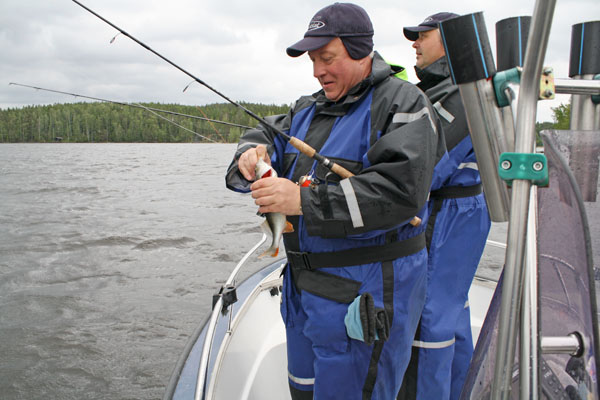 |
| Lake Rautavesi |
| When in pursuit of big perch, Petri mainly uses 5 cm grub jigs, but
fish-imitation jigs also get a game, especially when perch splash at the
surface. When the fish are in very shallow water, he uses a long-bodied, 4–5
gram jig head that floats well below the surface without becoming entangled
in bottom plants. In most cases, the jig head tied at the end of the line
weighs 5–7 grams – the deeper the fish, the heavier the jig should be. Motor oil colour is an infallible basic colour that works well during hot spells. White and yellow are also part of the standard tackle on Lake Ruovesi. Among fish-imitation jigs, monochrome lures, especially white as well as yellow and fish-coloured 4–5 cm jigs have proved to be effective. Fish jigs should be jerked more sharply than grub jigs in order to imitate the swim of a wounded fish. The ‘sillier’ the conspicuous bouncing of your fish jig, the more likely it is that a perch will snatch it. |
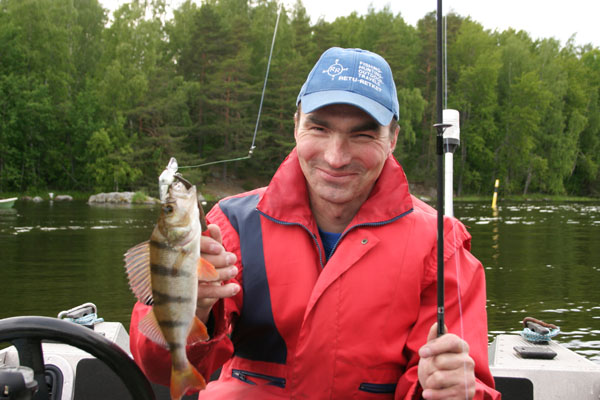 |
| Hot spots and bite times |
| Anglers jig perch
in spots where schools of small fry can be found. The best spots are
torrents and edges of shallows with vegetation at the bottom. You either
throw the jig where a perch is splashing at the surface, to the side of the
fry school, or over or to the front of the school. There is no point tossing
the jig in the middle of the school to unnecessarily cause it to scatter.
In the summer, peak bite times for big perch are in the early morning and late evening. Late morning is often a poor time. During the day, fish feed periodically, but once in a while you may even face a fierce attack. Towards the afternoon, feeding periods become more frequent and the period between 8 and 9 in the evening is often the best slot. Once you find big perch, it’s a good idea to wait around for feeding time – you can kill time by having a bite to eat yourself. When feeding starts, it’s usually voracious. The perch you catch will often bring up freshly swallowed fry on the bottom of your boat. You can use these for ‘cold tackle’, which you can set up while jigging. Cold tackle consists of an elastic rod and a Class 1 reel, with a monofilament line up to 0.18 mm or a 0.08–0.10 mm braided line. Attach a small, number 10–12 treble hook on the end of the line and then pass one of its legs through the baitfish under its dorsal fin. Add a light one-gram lead weight, which is just enough to sink the bait, at about 20 cm from the bait. Raise the bait at about 10–30 cm from the bottom, place the rod against the side of the boat and wait. When a perch takes the bait, first give it a couple of seconds to swallow it in peace. Once the fish really starts to pull the line, launch your counterattack and start reeling it in. You can also catch baitfish in advance using a fine-meshed trap or a hook and line. Useful parts of big roach include the tail and in particular the dorsal fin, which should come with a large chunk of flesh cut for the bait. Petri explains that cold tackle often catches the biggest ‘crook-necks’ of the trip. |
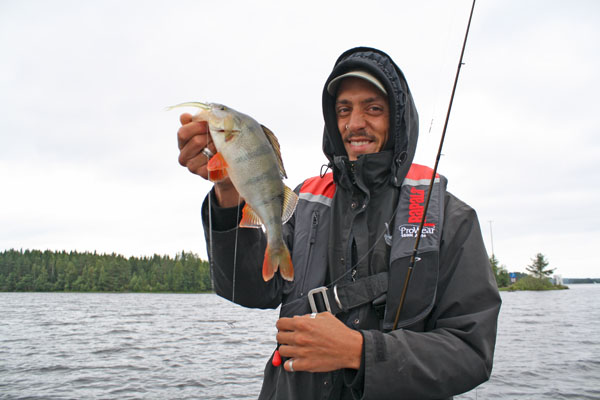 |
| Lake Ruovesi |
| Go deeper in the autumn |
| In a normal year,
the perch season continues through to late September. In August and
September, big perch dive deeper into banks and slopes. Torrent catches
decline and fishing focuses more clearly on shoals. This is when it is time
to switch to larger jig heads, weighing 10 to 17 grams, because perch can be
found as deep as 10 metres. It’s advisable to hang a big jig on a
long-stemmed hook in order to secure the perch firmly on the hook. Sometimes, perch can also be caught in the middle layers of water, when fish start biting while the jig is still sinking. In most cases, however, fishing at the bottom is your best bet in the autumn. According to Petri Ristiniemi’s observations, the current perch situation is looking very healthy, thanks to recent warm summers. The average size of perch has clearly increased and last summer, for example, Petri rarely returned from the waters with his largest perch weighing less than half a kilo. On many trips, the largest whoppers weighed between 700 and 800 grams. There have also been plenty of sightings of over one-kilo fish. |
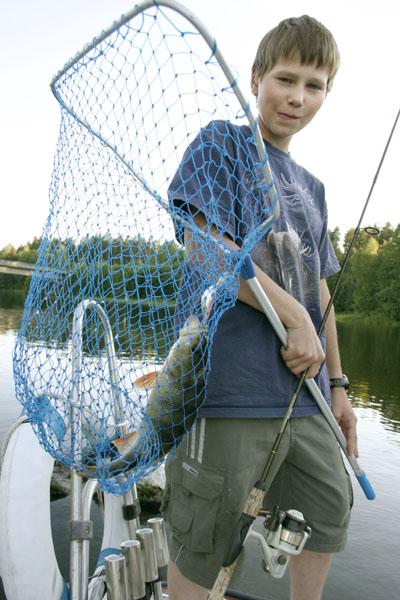 |